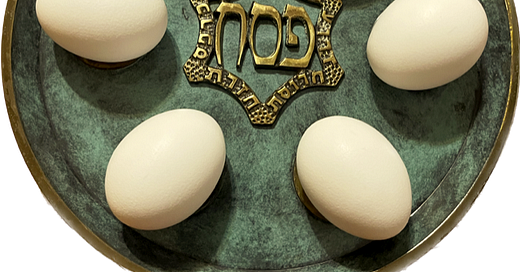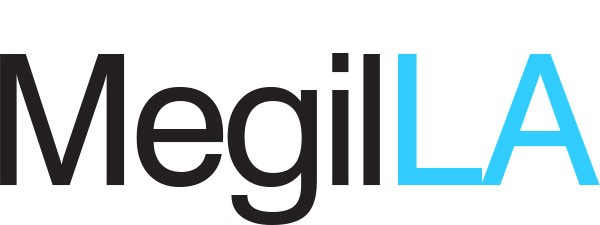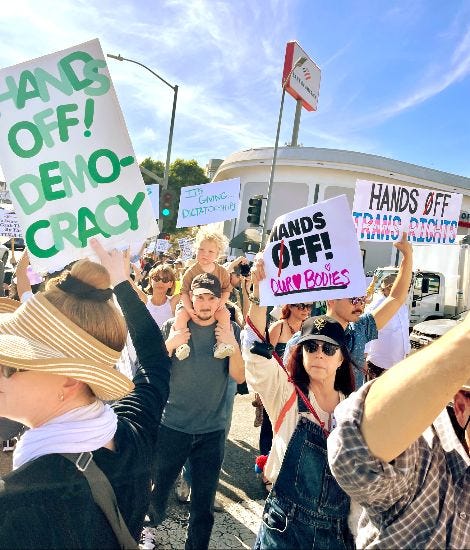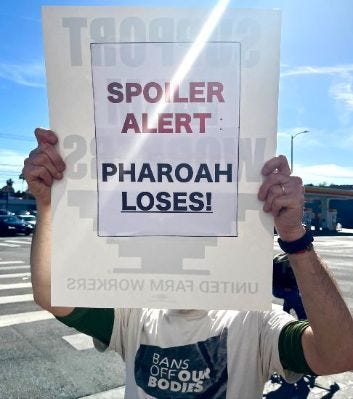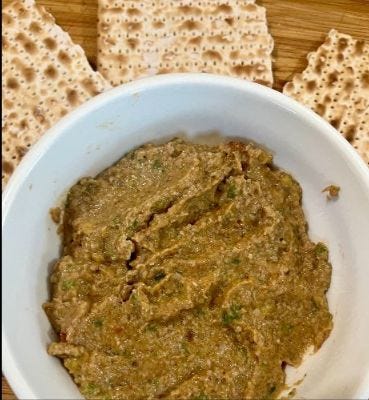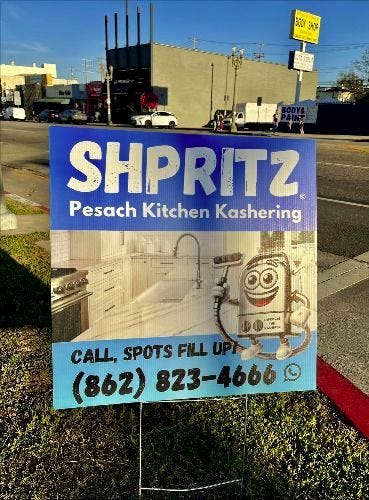Has the Seder Plate Egg Cost Your Freedom?
A New Scroll of LA Jewish News
Folks,
At Passover, the egg on our Seder plates has become too costly. At a time when we celebrate the going out from Egypt, has this high price, as well as that of other household commodities that swayed some voters to the right, cost us our freedom?
In WW II, during his annual address to Congress, President Franklin Roosevelt presented what he described as the “Four Freedoms,” the freedom of speech, the freedom of worship, the freedom of want, and freedom from fear. All are threatened by President Trump and his administration.
It would have been more than enough, dayenu, if only words of inclusion were forbidden in government documents, but news organizations have had their freedom limited too for not complying with Trump's policy.
It would have been more than enough, dayenu, if the agenda of conservative white Christians, mostly evangelical, was prioritized through the creation of the White House Faith Office, but Trump’s Task Force to Eradicate Anti-Christian Bias, could promote a Christian point of view over everyone else’s freedom of worship.
It would have been more than enough, dayenu, if it was just Trump's economic policy keeping food prices high, but his administration’s support of dramatic cuts to the Supplemental Nutrition Assistance Program (SNAP) will push many Americans into a place of need.
It would have been more than enough, dayenu, if as a result of dramatic shifts in government policy, just those who are undocumented lived in fear, but now those holding green cards, or student visas, as well as many LGBTQ people live in fear as well.
How can we revive our sense of freedom, regardless of the price of eggs?
At our yearly Passover Seder, the haggadah teaches us to ask questions, and to find answers; a process we need to continue afterwards. The retelling of the going out from Egypt reminds us to take action; to twist and pull at the chains of our bondage until they break. Only then can we say we are free.
…Before you sing about the goat that cost two zuzim, can you also think about sending some zuzim to me? Become a paid subscriber, or re-subscribe. I need your support to continue. Help me continue this effort. Please SUBSCRIBE today.
Shabbat Shalom
& Chag Sameach.
Edmon J. Rodman
////\/\\\\
////\/\\\\
Jews chant 'Hands off our freedom'
in Trump-ish neighborhood
Edmon J. Rodman
On a sunny Shabbat afternoon, April 5, there was a surprising development in Pico-Robertson, the Traditional Jewish neighborhood where Trump won the majority in November— an anti-Trump and Musk demonstration.
As part of the national Hands Off rallies, a gathering of between 700 and 800 demonstrators, most of them Jewish, gathered at the high traffic intersection of Pico and La Cienega to peacefully protest the recent federal government cuts initiated by Trump and Musk.
“This mass mobilization day is our message to the world that we do not consent to the destruction of our government and our economy for the benefit of Trump and his billionaire allies,” said a message from mobilize.us, sent to draw people to demonstrations held on Saturday.
At a time of day when some Jews are resting, sign-carrying demonstrators, positioned on each of the intersection’s four corners, formed an informal congregation chanting ardently that "Trump and Musk have got to go."
As the traffic lights changed, contingents of sign-carrying demonstrators paraded across the street, displaying their message of “Hands Off!” to drivers stopped at the intersection, who beeped their car horns in support.
Keeping with the day’s theme, participants held mostly handmade signs that demanded a Hands Off position to “Our Freedom of Speech,” “Our Social Security,” “Our Medicare,” constitution, public lands libraries, and religion.
One sign referred to Trump as a “Demented Dictator,” and another suggested “There are Nazis in the White House.” Another said, “All our outrage can’t fit on this sign.”
A sign featuring Smokey the Bear reminded that “Only YOU Can Prevent Oligarchy.”
With some of the demonstrators wearing kippot, and others dressed as if they had just come from shul, the sidewalk gathering had the feel of a temple social hall, with people catching up on family news between bursts of slogan chanting and car horns.
Countering the fact that in the November election, Pico-Robertson had stood out politically from much of the surrounding area, with three of the five precincts that touch the neighborhood favoring Donald Trump over Kamala Harris, as reported by the LA Times, Jews who lived or prayed in the neighborhood, including Traditional ones, attended the rally.
According to Alan Paul, who davens at a nearby minyan, the event was organized by word of mouth and social messaging, in response to the need of those in the neighborhood “who are shomer Shabbes,” and could not drive downtown to the larger demonstration.
Said an eye-catching hand-held sign, carried by one smiling demonstrator that seemed to capture the general mood: “We’ve Come to Expel the Hate.”
////\/\\\\
Charoset: This year's hot Seder recipe
Edmon J. Rodman
Why a hot charoset? Isn’t dipping our matzah in marror, horseradish, enough to evoke the pain of slavery? Usually, the sweet charoset is what we need to counter the bitterness. But not this year. When people who help us in our daily lives are forced into hiding, when the possibility of life-saving treatments created at university research hospitals calls code blue, while our retirement funds are jeopardized needlessly, plus Israelis still held hostage, this is a Passover of feeling the burn. Not eye-watering hot like horseradish, but hot enough to get your attention, this recipe was created as a way of adding a heightened taste of awareness to your seder.
Ingredients
1 ripe mango, diced
½ cup chopped walnuts
½ to 1 jalapeño pepper, diced
3 dates, cut into pieces
1 teaspoon cinnamon
¼ to ¾ teaspoon cayenne pepper, depending on how hot you want it.
2 pinches of salt
3 tablespoons of sweet wine
Directions
In a medium size bowl add the chopped walnuts, diced mango, and dates cut into pieces. Remove the seeds from the jalapeño and chop, and add to bowl. (You may wish to wear gloves while handling the jalapeño.) Add the cinnamon, salt, and cayenne pepper. Add the wine to mixture. Note: Start with ½ of jalapeño and ¼ teaspoon of cayenne pepper. Add more of each if you want a hotter charoset.
Place the mixture in a blender and set to chop. Blend until you have desired consistency. Serve at your seder with an outstretched arm.
////\/\\\\
*LIVE FROM THE ARCHIVE:
The marketing of Passover
Edmon J. Rodman
Over one hundred years ago in LA, where could you shop for Passover? It may be hard to imagine, but then there was no holiday display at Ralphs, or huge stack of matzah boxes at Costco.
How did we get from then to now?
Around 1905, the city’s Jewish population had grown to around 3000, and a market for the special foods required for Passover began to develop.
That year, Louis Hillman the owner of the Kosher Meat Market, at 509 E. First Street, (he was also the Torah reader at Congregation Beth Israel) ran some of the first ads for Passover foods in the B’nai B’rith Messenger.
According to the ad, a shopper preparing for Passover could buy at his market “matzos, matzo flour, wine, sugar, and all other necessities for the coming Passover Holidays.”
The ad was a wise buy, as in that period, there were Jewish households in the vicinity of his market to make the investment worthwhile.
By 1915, when the Jewish population had grown to over 10,000, a Passover shopper had new choices. As shown by an ad in the Messenger, they could go about a mile from Hillman’s kosher market to a non-kosher store, the Palace Market (pictured above in a postcard) owned by Matthew Everhardy, (who was not Jewish) at 622 S. Broadway, to buy from a “Fresh Stock of Kosher Goods For The Passover.”
Included at the market were matzos and matzo meal, cake flour, farfel, and “a full line of kosher sausage, smoked meats and delicatessen.” Not a one-off ad, it represented a serious marketing effort, running 11 times from January until April 1915.
Since Palace Market was not kosher (you can see hams hanging in the foreground), why were they selling kosher for Passover provisions? It would seem, this is an early example of selling specialized kosher holiday foods in a general market, a trend that continues until today, and why you can shop at Ralphs, Costco, or Pavilions for Passover, in addition to kosher stores.
However, why many of the supermarkets put out the matzah at Hanukkah, is still anybody’s guess.
*The Rodman Archive of Los Angeles Jewish History is a collection of approximately 1500 objects, photos, clothing, art, books, recordings, and ephemera relating to the lives and endeavors of Jewish Angelenos between 1850 and 1980.
////\/\\\\
See the Jewish world novelly
Photo Daniel Rhone
The stories of a talking cat, a barnstorming Jewish baseball team, and Palestinians and Israelis competitively digging tunnels alongside one another in search of treasure, are among the themes of a class titled “Comics, Cultures, and Communities, The Jewish World in Graphic Novels” coming to the Skirball Cultural Center in May.
Whether based in Algeria, Prague or Santa Fe, each of the graphic novels to be examined connects with an often overlooked or misunderstood community of the Jewish world.
Presented by Dr. David Greenfield, a Los Angeles educator with a lifelong interest in comics and graphic novels, the class will meet on six Sundays in May and June, from 11 to 2:30 pm.
For more info click HERE.
////\/\\\\
Seen on the way: Pico-Robertson
To get ready for Passover, it usually takes more than a shpritz, more like a torrent. When you hear someone, mostly women because the task often falls to them, state their objections to Passover preparation, cleaning and kashering are most often cited. Especially for the non-Tradtional Jew, cleaning the house of chametz (anything leavened and more), from oven to keyboard, can seem cause for a personal exodus. Fitting out the cupboards with fresh new shelving paper, and the counter tops with foil or plastic can also seem like an exercise in OCD. Should the answer to “Why is this night different from all others” be, “there are no crumbs between our couch cushions”? Yet, every spring, taking heightened care in our cleaning and kashering, is how some of us prepare for a week of difference, and a sense of reawakened conscious living.
////\/\\\\

